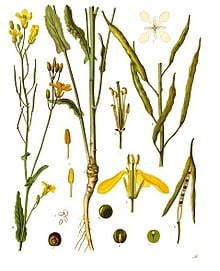Rapeseed

Rapeseed (Brassica napus subsp. napus) is a bright-yellow flowering member of the family Brassicaceae (mustard or cabbage family), cultivated mainly for its oil-rich seed, which naturally contains appreciable amounts of erucic acid. Canola are a group of rapeseed cultivars which were bred to have very low levels of erucic acid and are especially prized for use for human and animal food. Rapeseed is the third-largest source of vegetable oil and second-largest source of protein meal in the world.
The term “rape” derives from the Latin word for turnip, rapa or rapum, cognate with the Greek word rhapys.[2]
The species Brassica napus belongs to the flowering plant family Brassicaceae. Rapeseed is a subspecies with the autonym B. napus subsp. napus.[3] It encompasses winter and spring oilseed, vegetable and fodder rape.[4] Siberian kale is a distinct leaf rape form variety (B. napus var. pabularia) which used to be common as a winter-annual vegetable.[5][4] The second subspecies of B. napus is B. napus subsp. rapifera (also subsp. napobrassica; the rutabaga, swede, or yellow turnip).[6][7]
Brassica napus is an digenomic amphidiploid that occurred due to the interspecific hybridization between Brassica oleracea and Brassica rapa.[8] It is a self-compatible pollinating species like the other amphidiploid brassica species.[9]
